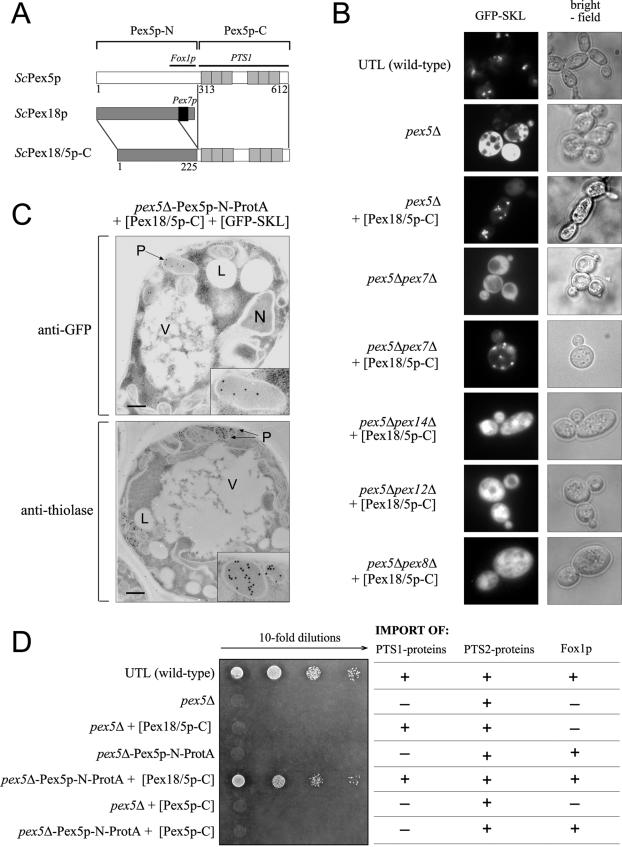FIG.6.
The chimeric protein Pex18/5p-C can mediate the import of PTS1 proteins into peroxisomes. (A) Construction of the chimeric protein Pex18/5p-C was carried out by replacing the Pex7p binding box of Pex18p (black box) with the C-terminal half of Pex5p containing the PTS1 binding TPR motifs (grey). (B) The intracellular localization of the plasmid-encoded PTS1 protein GFP-SKL in a pex5Δ strain is affected by expression of a Pex18/5p-C chimeric protein. Wild-type UTL-7A, pex5Δ, and pex5Δ pex7Δ cells, as well as pex5Δ, pex5Δ pex7Δ, pex5Δ pex14Δ, pex5Δ pex12Δ, and pex5Δ pex8Δ cells expressing Pex18/5p-C, were grown for 14 h in oleic acid medium and analyzed by fluorescence microscopy. Bright-field microscopy demonstrated structural integrity of the cells. (C) Morphological and immunocytochemical analysis of pex5Δ-Pex5p-N-ProtA cells expressing both the chimeric protein Pex18/5p-C and GFP-SKL. All cells were grown for 12 h in oleic acid medium and fixed in glutaraldehyde. For immunogold labeling, antibodies raised against GFP or 3-ketoacyl-CoA thiolase and gold-conjugated goat anti-rabbit antibodies were used. The insets show magnifications of representative peroxisomal structures. L, lipid drops; M, mitochondria; N, nucleus. Bars, 1 μm. (D) Expression of the chimeric protein Pex18/5p-C rescues the PTS1 import defect of cells expressing Pex5p-N instead of full-length Pex5p. As the beta-oxidation system in S. cerevisiae comprises members of all three classes of peroxisomal matrix proteins (PTS1, PTS2, and non-PTS1/2 proteins), growth on oleate is an assay for the functionality of all three import routes (e.g., growth of wild-type cells demonstrates that all import pathways are functional, as illustrated in the table). For this assay cells were grown in medium containing 0.3% glucose for 16 h. Equal numbers of cells were diluted in distilled water, and aliquots were applied as a series of 10-fold dilutions on an oleic acid plate, whereas the spots on the left correspond to 2 × 104 cells. The growth plate was subsequently incubated at 30°C for 5 days. The partial import defects of cells expressing only the chimeric Pex18/5p-C (pex5Δ cells transformed with Pex18/5p-C expression plasmid) or Pex5p-N (pex5Δ-Pex5p-N-ProtA) can be rescued when both proteins are expressed together (pex5Δ-Pex5p-N-ProtA strain transformed with Pex18/5p-C expression plasmid). The C-terminal half of Pex5p alone (Pex5p-C), not fused to Pex18p, is not able to mediate import of PTS1 proteins. This is demonstrated by the inability of the pex5Δ-Pex5p-N-ProtA strain, transformed with Pex5p-C expression plasmid, to grow on oleate.

